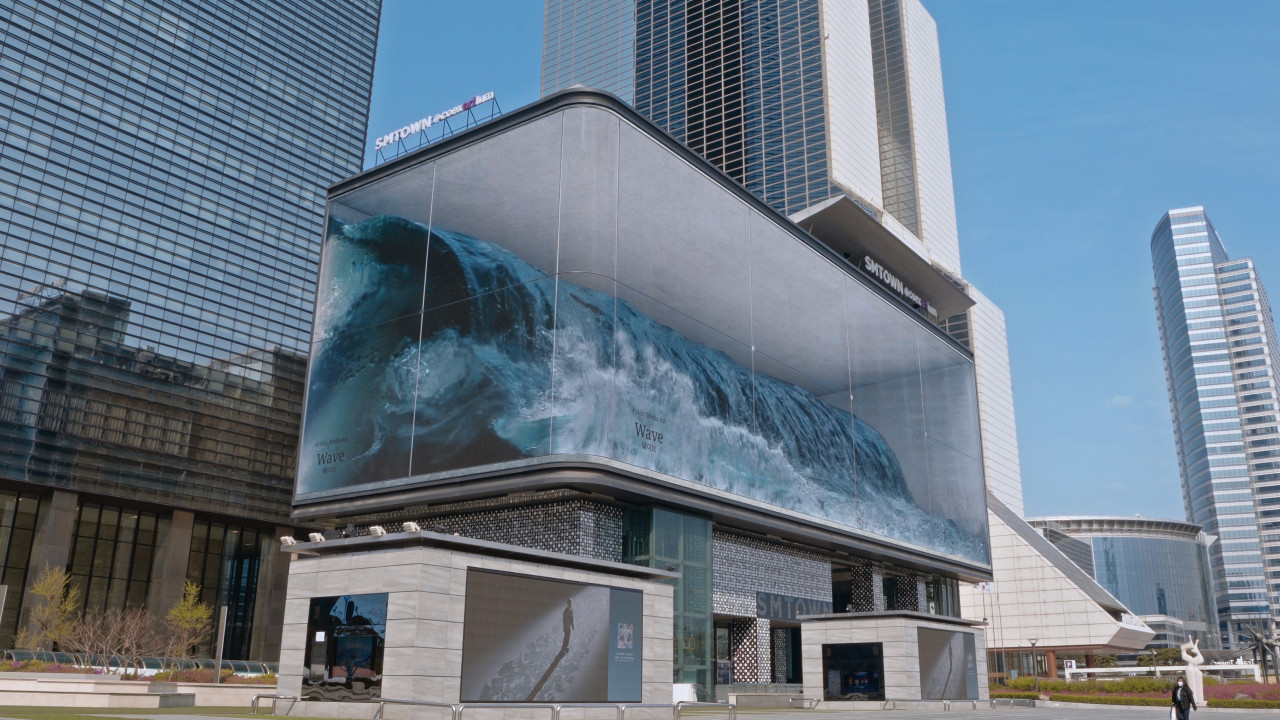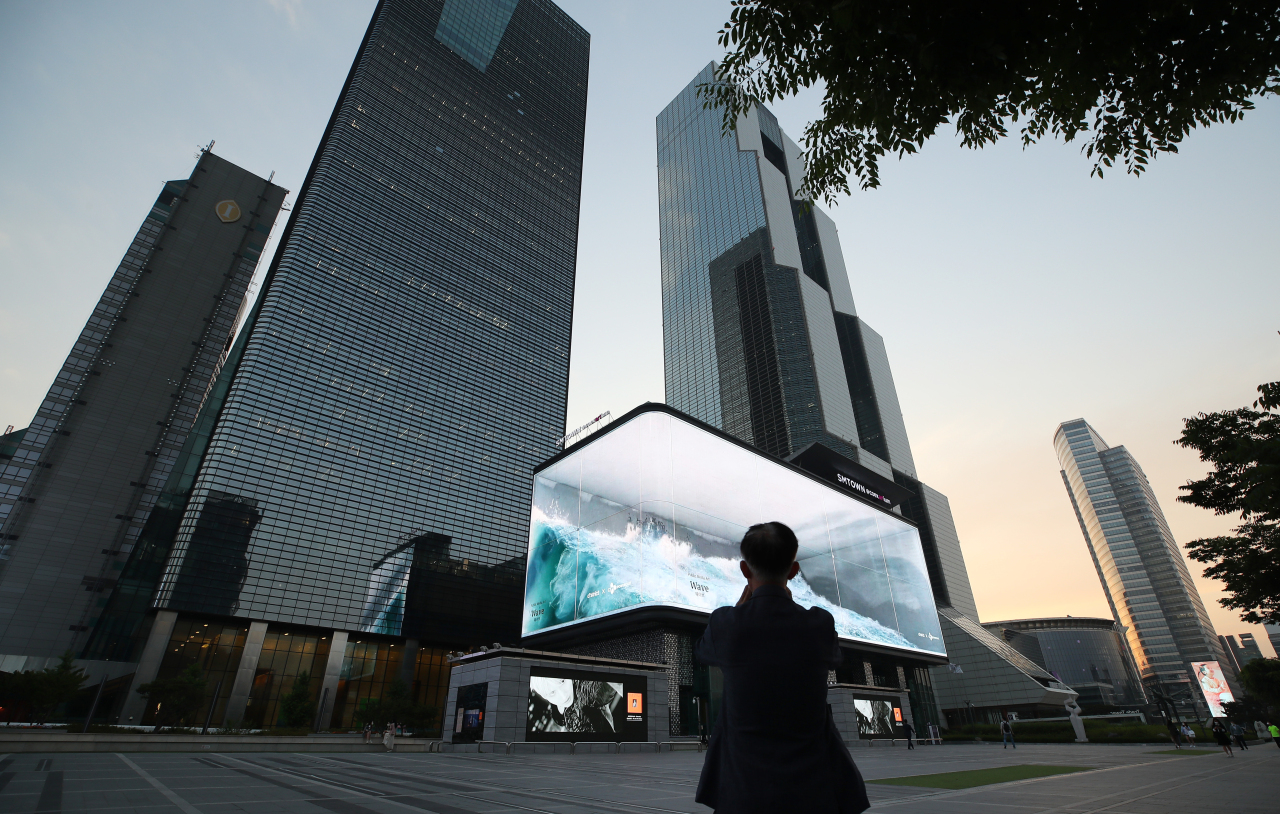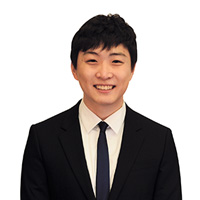‘Wave’ on Coex digital billboard grabs international attention
By Lim Jang-wonPublished : May 26, 2020 - 15:48

A minute-long video of a wave crashing screened on Korea’s biggest digital display at Coex K-pop Square has become the talk of the town, receiving local as well as international media coverage.
The video of wave crashing down, made using anamorphic illusion by design company d’strict titled “Wave,” makes the display panel seem like a giant glass tank holding water. The curved screen made such illusion possible, but the design and application took more than three months to develop.
The realistic representation of the force of nature grabs the attention of passersby with its deep blue color and lively motion.
“LED screens are usually set up in crowded metropolitan areas. We thought seeing an unexpected scene in the middle of tall buildings would grab people’s attention,” said Lee Sung-ho, CEO of d’strict. “We plan to get motives from nature moving forward so people can also experience healing within the city,” he said.
Samseong-dong in Seoul, where Coex is located, was declared Korea’s first free outdoor advertising zone in 2018, which means there is no restriction to the size or type of advertisement allowed on the billboards. This has allowed the Coex area to be transformed into Korea’s Times Square with large LED screens placed throughout the area.
The large screen signage in Coex K-pop Square built in March, 2018 by Samsung Electronics, CJ Powercast and Korea International Trade Association is the largest LED screen in Korea, measuring 81 meters wide and 20 meters tall, enough to fit four basketball courts.
The screen also serves as a public gathering place, screening events such as the World Cup, for which 40,000 people gathered in 2018, and movie festivals as well as New Year’s countdown.
With large LED screens becoming more available around the world, the demand for public media art that can be shown on the screens has also grown.
“In the future, more companies will have this kind of large-scale LED screens. These companies usually earn money from commercials on the screens, but there is also a demand for public media art. Making public media art every time is a burden for the companies, so we thought of making media art that people will enjoy and license it to screens around the world,” said Lee.
“Wave” was only supposed to be up on Coex K-pop Square for the month of April, but the positive reaction allowed it to be on display again starting May 20, and is now shown every 30 minutes for 90 seconds.
The billboard typically carries commercial advertisements, ranging from K-pop music videos to electronics goods.
The project was given for free to CJ Powercast, which holds 70 percent ownership of the billboard and manages it, but Lee hopes to earn profit from licensing the work to places like the Times Square in the future.
Another d’strict project, “Soft Body,” which was featured in Coex in April, shows everyday items approaching and colliding with the screen while making them look soft. The video is more surrealism art than realistic representation. The next project d’strict is preparing is the “Whale,” which will feature an imaginary whale swimming around in the big screen acting as a water tank.

While the Samseong-dong area is striving to turn into Korea’s Time Square, complaints of light pollution is something that need to be considered.
“Complaints about light pollution have been rising in Gangnam-gu since we allowed LED displays,” said a district official, who declined to provide further details.
Meanwhile, revisions to the Light Pollution Prevention Act which was passed by the National Assembly on May 12, will come into effect May 27. The act aims to prevent excessive artificial light that can harm people’s health or environment. The revision imposes heavier fines on violators and allows local governments to request inspection by the Light Pollution Examining Facility.
Complaints of light pollution have been steadily rising in Korea since 2014, reaching 7,002 cases in 2018. Of those, 3,870 (55.3 percent) were complaints regarding sleep disturbance and 1,399 (20 percent) were complaints regarding damage to crops, according to the Ministry of Environment.
By Lim Jang-won (ljw@heraldcorp.com)
-
Articles by Lim Jang-won




















![[Today’s K-pop] BTS pop-up event to come to Seoul](http://res.heraldm.com/phpwas/restmb_idxmake.php?idx=642&simg=/content/image/2024/04/17/20240417050734_0.jpg&u=)